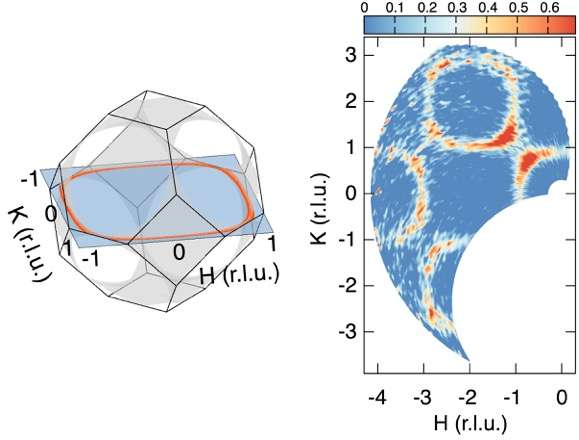Neutrons prove the existence of 'spiral spin-liquid'

Magnetic moments ("spins") in magnetic solids are capable of forming the most diverse structures. Some of them are not only of interest from a scientific point of view, but also from a technical standpoint: processors and storage media making use of these tiny structures could one day lead to the further miniaturization of IT devices and improve their energy efficiency significantly.
A team of researchers from Switzerland, Germany, Moldavia and France have now proved the existence of a new spiral-shaped magnetic structure: They found indications of a so-called "spiral spin-liquid" structure in manganese scandium thiospinel single crystals (MnSc2S4) at low temperatures. Neighbouring spins fluctuate here collectively as spirals, but when spatial distances are involved, they do not take on a particular order, just as water molecules will only form structures with nearby molecules.
"Spiral spin-liquid" structures were already predicted in 2007. "A characteristic feature of this type of system is the so-called "spiral surface" – a continuous surface of spiral propagation vectors in reciprocal space", explained Dr. Yixi Su, instrument scientist at the diffuse scattering neutron time of flight spectrometer (DNS), an instrument of the Jülich Centre for Neutron Science (JCNS) at its outstation at the Heinz Maier-Leibnitz Zentrum. It is exactly this pattern that could now be verified with the use of polarized diffuse neutron scattering at the DNS instrument.
Proving this was not easy; Yixi Su describes the challenges that the researchers had to overcome. "For the experiments, we needed sample materials which were free of any defects and exactly stoichiometric. These are very difficult to produce in large quantities. In the end, we had to make do with only around 30 milligrams of crystals. As measurements with a high count-rate, low background and polarisation analysis are possible at DNS, even this small quantity of sample material was sufficient to establish direct proof of the spiral surface"
More information: Shang Gao et al, Spiral spin-liquid and the emergence of a vortex-like state in MnSc2S4, Nature Physics (2016). DOI: 10.1038/nphys3914
Journal information: Nature Physics
Provided by Forschungszentrum Juelich



















